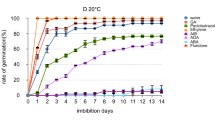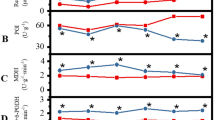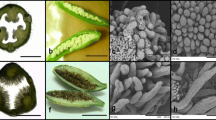Abstract
The sunflower embryo is surrounded by a one-layered endosperm and a unitegmic seed coat, which are multifunctional tissues involved in dormancy and germination of sunflower seeds. Abscisic acid (ABA) and gibberellins (GAs), together with other phytohormones such as auxins (AUX) and Jasmonates (JAs), play an antagonist role in the regulation of seed germination and dormancy. Here, we investigated the role of the seed coat and endosperm in the imposition and release of sunflower seed dormancy in two inbred Helianthus annuus lines (B123 and B91), and evaluated the endogenous level of ABA, jasmonic acid (JA) and indol-3-acetic acid (IAA) in these tissues (either dry or imbibed). Histological analyses of these tissues were also performed in dry cypselas of both lines. The seed coat and endosperm, along with the embryo, displayed a relevant contribution in the imposition of seed dormancy in B123 line. B123 seed dormancy could be associated with a low content of ABA, JA and IAA in the seed coat and endosperm, and a high content of these phytohormones in the embryo. The release of B123 seed dormancy after a dry storage period showed increased ABA and JA contents in the seed coat and endosperm, but decreased levels in the embryo. The seed coat and endosperm, as well as the embryo showed a reduction in IAA after the storage period. Thus, the hormone metabolism and interaction between seed tissues play a relevant role in the release of B123 seed dormancy. The anatomy of the seed coat and one-layered endosperm showed no relevant differences between lines. Altogether, our results remark the relevance of the interaction between the seed coat, endosperm and embryo in the release of dormancy in sunflower seeds.











Similar content being viewed by others
References
Ali F, Qanmber G, Li F, Wang Z (2022) Updated role of ABA in seed maturation, dormancy, and germination. J Adv Res 35:199–214. https://doi.org/10.1016/j.jare.2021.03.011
Adeleke BS, Babalola OO (2020) Oilseed crop sunflower (Helianthus annuus) as a source of food: Nutritional and health benefits. Food Sci Nutr 8:4666–4684. https://doi.org/10.1002/fsn3.1783
Andrade A, Riera N, Lindström L et al (2015) Pericarp anatomy and hormone profiles of cypselas in dormant and non-dormant inbred sunflower lines. Plant Biol 17:351–360. https://doi.org/10.1111/plb.12244
Bentsink L, Koornneef M (2008) Seed dormancy and germination. TAB 6 http://10.0.4.175/tab.0050
Bethke PC, Libourel IG, Aoyama N, Chung YY, Still DW, Jones RL (2007) The Arabidopsis aleurone layer responds To nitric oxide, gibberellin, and abscisic acid and is sufficient and necessary for seed dormancy. Plant Physiol143:1173–1188. https://doi.org/10.1104/pp.106.093435
Bodrone MP, Rodríguez MV, Arisnabarreta S, Batlla D (2017) Maternal environment and dormancy in sunflower: the effect of temperature during fruit development. Europ J Agronomy 82:93–103. https://doi.org/10.1016/j.eja.2016.10.007
Brunick R (2007) Seed dormancy in domesticated and wild sunflowers (Helianthus annuus L.): types, longevity and QTL discovery. PhD Thesis, Oregon State University Department of Horticulture
Casanova-Sáez R, Mateo-Bonmatí E, Ljung K (2021) Auxin metabolism in plants. Cold Spring Harb Perspect Biology 1:13. https://doi.org/10.1101/cshperspect.a039867
Dave A, Hernández ML, He Z et al (2011) 12-Oxo-phytodienoic acid accumulation during seed development represses seed germination in Arabidopsis. Plant Cell 23:583–59910. https://doi.org/10.1105/tpc.110.081489
Dave A, Graham IA (2012) Oxylipin signalling: a distinct role for the jasmonic acid precursor 12-oxo-phytodienoic acid (OPDA). Front Plant Sci 3:42. https://doi.org/10.3389/fpls.2012.00042
Dave A, Vaistij FE, Gilday AD, Penfield SD, Graham IA (2016) Regulation of Arabidopsis thaliana seed dormancy and germination by 12-oxo-phytodienoci acid. J Exp Bot 67:2277–2284. https://doi.org/10.1093/jxb/erw028
Debeaujon I, Koornneef M (2000) Gibberellin requirement for Arabidopsis seed germination is determined both by testa characteristics and embryonic abscisic acid. Plant Physiol 122:415–424. https://doi.org/10.1104/pp.122.2.415
Debeaujon I, Lepiniec L, Pourcel L, Routaboul JM (2007) Seed coat development and dormancy. In: Bradford K, Nonogaki H (eds) Seed development, dormancy and germination, Blackwell Publishing, pp 25–43
Di Rienzo JA, Casanoves F, Balzarini MG, Gonzalez L, Tablada M (2013) InfoStat versión 2013. Grupo InfoStat, FCA, Universidad Nacional de Córdoba, Argentina. URL http://www.infostat.com.ar
Dominguez CP, Batlla D, Rodríguez MV, Windauer LB, Gerbaldo M, Benech-Arnold RL (2016) Pericarp‐Imposed dormancy in sunflower: physiological basis, impact on Crop Emergence, and removal at an Industrial Scale. Crop Sci 56:716–726. https://doi.org/10.2135/cropsci2015.06.0335
Durgbanshi A, Arbona V, Pozo O, Miersch O, Sancho JV, Gómez-Cadenas A (2005) Simultaneous determination of multiple phytohormones in plant extracts by liquid chromatography-electrospray tandem mass spectrometry. J Agric Food Chem 53:8437–8442. https://doi.org/10.1021/jf050884b
El-Maarouf-Bouteau H, Sajjad Y, Bazin J et al (2015) Reactive oxygen species, abscisic acid and ethylene interact to regulate sunflower seed germination. Plant Cell Environ 38:364–374. https://doi.org/10.1111/pce.12371
El-Maarouf-Bouteau H (2022) The seed and the metabolism regulation. Biol 11:168. https://doi.org/10.3390/biology11020168
Emenecker RJ, Strader LC (2020) Auxin-Abscisic Acid interactions in plant growth and development. Biomolecules 10:281. https://doi.org/10.3390/biom10020281
Figueiredo DD, Batista RA, Roszak PJ, Köhler C (2016) Auxin production couples endosperm development to fertilization. Nat Plants 1:15184. https://doi.org/10.1038/nplants.2015.184
Figueiredo DD, Köhler C (2018) Auxin: a molecular trigger of seed development. Genes Dev 32:479–490. https://doi.org/10.1101/gad.312546.118
Finch-Savage WE, Bassel GW (2016) Seed vigour and crop establishment: extending performance beyond adaptation. J Exp Bot 67:567–591. https://doi.org/10.1093/jxb/erv490
Fukui K, Hayashi KI (2018) Manipulation and sensing of Auxin Metabolism, Transport and Signaling. Plant Cell Physiol 59:1500–1510. https://doi.org/10.1093/pcp/pcy076
Górnik K, Gresik M, Janas R, Zurawicz E, Chojnowska W, Góralska R (2018) The effect of apple seed stratification with growth regulators on breaking the dormancy of seeds, the growth of seedlings and chlorophyll fluorescence. J Hortic Res 26:37–44. https://doi.org/10.2478/johr-2018-0004
Hermann K, Meinhard J, Dobrev P et al (2007) 1-Aminocyclopropane-1-carboxylic acid and abscisic acid during the germination of sugar beet (Beta vulgaris L.): a comparative study of fruits and seeds. J Exp Bot 58:3047–3060. https://doi.org/10.1093/jxb/erm162
Hussain S, Kim SH, Bahk S et al (2020) The auxin signaling repressor IAA8 promotes seed germination through down-regulation of ABI3 transcription in Arabidopsis. Front Plant Science 11:111. https://doi.org/10.3389/fpls.2020.00111
Iglesias-Fernández R, Matilla AJ, Pulgar I, de la Torre F (2007) Ripe fruits of Sisymbrium officinale L. contain heterogeneous endospermic seeds with different germination rates. Seed Sci and Biotechnol 2:18–24
Jacobsen JV, Barrero JM, Hughes T et al (2013) Roles for blue light, jasmonate and nitric oxide in the regulation of dormancy and germination in wheat grain (Triticum aestivum L). Planta 238:121–138. https://doi.org/10.1007/s00425-013-1878-0
Kozaki A, Aoyanagi T (2022) Molecular aspects of seed development controlled by Gibberellins and Abscisic acids. Int J Mol Sci 23:1876. https://doi.org/10.3390/ijms23031876
Lachabrouilli AS, Rigal K, Corbineau F, Bailly C (2021) Effects of agroclimatic conditions on sunflower seed dormancy at harvest. Eur J Agron 124:126209. https://doi.org/10.1016/j.eja.2020.126209
Lee KP, Piskurewicz U, Tureckova V, Strnad M, Lopez-Molina L (2010) A seed coat bedding assay shows that RGL2-dependent release of abscisic acid by the endosperm controls embryo growth in Arabidopsis dormant seeds. PNAS 107:19108–19113. https://doi.org/10.1073/pnas.1012896107
Lefebvre V, North H, Frey A, Sotta B, Seo M, Okamoto M, Nambara E, Marion-Poll A (2006) Functional analysis of Arabidopsis NCED6 and NCED9 genes indicates that ABA synthesized in the endosperm is involved in the induction of seed dormancy. Plant J 45:309–319. https://doi.org/10.1111/j.1365-313X.2005.02622.x
Liu X, Zhang H, Zhao Y et al (2013) Auxin controls seed dormancy through stimulation of abscisic acid signaling by inducing ARF-mediated ABI3 activation in Arabidopsis. PNAS 110:15485–15490. https://doi.org/10.1073/pnas.1304651110
Matilla AJ (2019) Seed coat formation: its evolution and regulation. Seed Sci Res 1:12. doi:https://doi.org/10.1017/S0960258519000254
Matilla AJ (2020) Auxin: hormonal signal required for seed development and dormancy. Plants 9:705. https://doi.org/10.3390/plants9060705
Nonogaki H (2017) Seed biology updates - highlights and new discoveries in seed dormancy and germination research. Front Plant Sci 8:524. https://doi.org/10.3389/fpls.2017.00524
Nonogaki H (2019) Seed germination and dormancy: the classic story, new puzzles, and evolution. J Integr Plant Biol 61:541–563. https://doi.org/10.1111/jipb.12762
Palacio C (2014) Ácido abscísico y giberelinas: su participación en la dormición y germinación de semillas de girasol (Helianthus annuus L.). Thesis for graduate degree. National University of Río Cuarto
Pan J, Hu Y, Wang H, Guo Q, Chen Y, Howe GA (2020) Molecular mechanism underlying the synergetic effect of jasmonate on abscisic acid signaling during seed germination in Arabidopsis. Plant Cell 32:3846–3865. https://doi.org/10.1105/tpc.19.00838
Park J, Kim YS, Kim SG, Jung JH, Woo JC, Park CM (2011) Integration of auxin and salt signals by the NAC transcription factor NTM2 during seed germination in Arabidopsis. Plant Physiol 156:537–549. https://doi.org/10.1104/pp.111.177071
Radchuk V, Borisjuk L (2014) Physical, metabolic and developmental functions of the seed coat. Front Plant Sci 5:510. https://doi.org/10.3389/fpls.2014.00510
Rodriguez MV, Toorop PE, Benech-Arnold RL (2011) Challenges facing seed banks and agriculture in relation to seed quality. In: Kermode AR (ed) Seed dormancy: methods and protocols, methods in Molecular Biology. Humana Press, New York, pp 17–40
Roselló P, Vigliocco A, Andrade A et al (2016) Differential hormonal and gene expression dynamics in two inbred sunflower lines with contrasting dormancy level. Plant Physiol Biochem 102:133–140. https://doi.org/10.1016/j.plaphy.2016.02.021
Sano N, Marion-Poll A (2021) ABA metabolism and homeostasis in seed dormancy and germination. Int J Mol Sci 22:5069. https://doi.org/10.3390/ijms22105069
Seiler GJ (1997) Anatomy and morphology of sunflower. Sunflower technology and production. Ed. American Society of Agronomy, Crop Society of America, Soil Science Society of America. Madison, Wisconsin, USA. 834 pp
Shu K, Liu XD, Xie Q, He ZH (2016) Two faces of one seed: hormonal regulation of dormancy and germination. Mol Plant 9:34–45. https://doi.org/10.1016/j.molp.2015.08.010
Shuai H, Meng Y, Luo X et al (2016) The roles of auxin in seed dormancy and germination. Yi Chuan = Hereditas 38:314–322. https://doi.org/10.16288/j.yczz.15-464
Shuai H, Meng Y, Luo X et al (2017) Exogenous auxin represses soybean seed germination through decreasing the gibberellin/abscisic acid (GA/ABA) ratio. Sci Rep 7:12620. https://doi.org/10.1038/s41598-017-13093-w
Singh P, Dave A, Vaistij FE et al (2017) Jasmonic acid-dependent regulation of seed dormancy following maternal herbivory in Arabidopsis. New Phytol 214:1702–1711. https://doi.org/10.1111/nph.14525
Skubacz A, Daszkowska-Golec A, Szarejko I (2016) The role and regulation of ABI5 (ABA-Insensitive 5) in plant development, abiotic stress responses and phytohormone crosstalk. Front Plant Sci 7:1884. https://doi.org/10.3389/fpls.2016.01884
Skubacz A, Daszkowska-Golec A (2017) Seed Dormancy: The complex process regulated by abscisic acid, gibberellins, and other phytohormones that makes seed germination work. In: El-Esawi M (ed) Phytohormones - signaling mechanisms and crosstalk in plant development and stress responses, Intech pp 77–100. https://doi.org/10.5772/intechopen.68735
Szemruch CL, Renteria SJ, Moreira F, Cantamutto MA, Ferrari L, Rondanini DP (2014) Germination, vigour and dormancy of sunflower seeds following chemical desiccation of female plants. Seed Sci Technol 42:454–460. https://doi.org/10.15258/sst.2014.42.3.12
Tuan PA, Kumar R, Rehal PK, Toora PK, Ayele BT (2018) Molecular Mechanisms underlying abscisic Acid/Gibberellin balance in the control of seed dormancy and germination in Cereals. Front Plant Sci 9:668. https://doi.org/10.3389/fpls.2018.00668
Vigliocco A, Del Bel Z, Pérez-Chaca MV et al (2019) Spatiotemporal variations in salicylic acid and hydrogen peroxide in sunflower seeds during transition from dormancy to germination. Physiol Plant 169:27–39. https://doi.org/10.1111/ppl.13043
Vigliocco AE, Andrade AM, Lindström LI, Alemano SG (2017) Dormancy in sunflower line A-3: the role of the pericarp. Botany 95:853–858. https://doi.org/10.1139/cjb-2016-0272
Wang LR, Yang XN, Gao YS et al (2019) Investigating seed dormancy in cotton (Gossypium hirsutum L.): understanding the physiological changes in embryo during after-ripening and germination. Plant Biol 21:911–919. https://doi.org/10.1111/plb.13005
Wasternack C, Forner S, Strnad M, Hause B (2013) Jasmonates in flower and seed development. Biochimie 95:79–85. https://doi.org/10.1016/j.biochi.2012.06.005
Xia Q, Ponnaiah M, Thanikathansubramanian K et al (2018) Re-localization of hormone effectors is associated with dormancy alleviation by temperature and after-ripening in sunflower seeds. Sci Rep 9:4861. https://doi.org/10.1038/s41598-019-40494-w
Xu L, Tang Y, Gao S, Su S, Hong L, Wang W (2016) Comprehensive analyses of the annexin gene family in wheat. BMC Genomics 17:415. https://doi.org/10.1038/s41598-019-40494-w
Yan A, Chen Z (2017) The pivotal role of abscisic acid signaling during transition from seed maturation to germination. Plant Cell Rep 36:689–703. https://doi.org/10.1007/s00299-016-2082-z
Yeh CH, Chen KY, Lee YI (2021) Asymbiotic germination of Vanilla planifolia in relation to the timing of seed collection and seed pretreatments. Bot Stud 62:1–12. https://doi.org/10.1186/s40529-021-00311-y
Yildiz K, Muradoglu F, Yilmaz H (2008) The effect of jasmonic acid on germination of dormant and nondormant pear (Pyrus communis L.) seeds. Seed Sci Technol 36:569–574
Zar JH (1996) Biostatistical analysis, 3rd ed. New Jersey, USA
Zhu CC, Wang CX, Lu CY, Wang JD, Zhou Y, Xiong M, Li QF (2021) Genome-wide identification and expression analysis of OsbZIP09 target genes in rice reveal its mechanism of controlling seed germination. Int J Mol Sci 22:1661. https://doi.org/10.3390/ijms22041661
Acknowledgements
We thank Mariela Woelke for her support during laboratory experiments and Dr. Julia Sabio Garcia for critical reading of this manuscript. The authors also thank Dr. Claudia Nome for the analysis of electronic images done by TEM. This project was supported by grants PICT-2018-02803 of the MINCyT-Argentina and PPI-2022 of the University of Río Cuarto. Z.D.B. held a post-graduate scholarship from CONICET, the National Research Council of Argentina.
Author information
Authors and Affiliations
Corresponding author
Ethics declarations
Conflict of interest
The authors declare no conflicts of interest.
Additional information
Communicated by Vijay Pratap Singh.
Publisher’s Note
Springer Nature remains neutral with regard to jurisdictional claims in published maps and institutional affiliations.
Rights and permissions
Springer Nature or its licensor (e.g. a society or other partner) holds exclusive rights to this article under a publishing agreement with the author(s) or other rightsholder(s); author self-archiving of the accepted manuscript version of this article is solely governed by the terms of such publishing agreement and applicable law.
About this article
Cite this article
Del Bel, Z., Andrade, A., Lindström, L. et al. The role of the sunflower seed coat and endosperm in the control of seed dormancy and germination: phytohormone profile and their interaction with seed tissues. Plant Growth Regul 102, 51–64 (2024). https://doi.org/10.1007/s10725-023-00967-5
Received:
Accepted:
Published:
Issue Date:
DOI: https://doi.org/10.1007/s10725-023-00967-5




